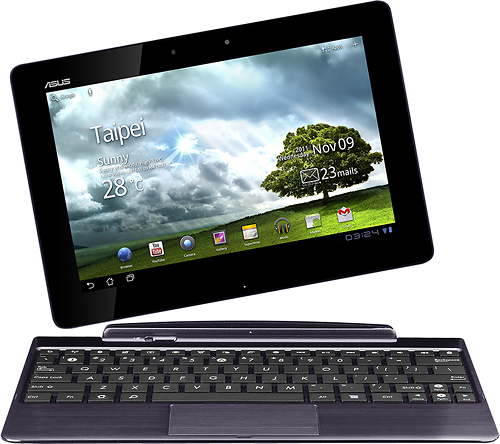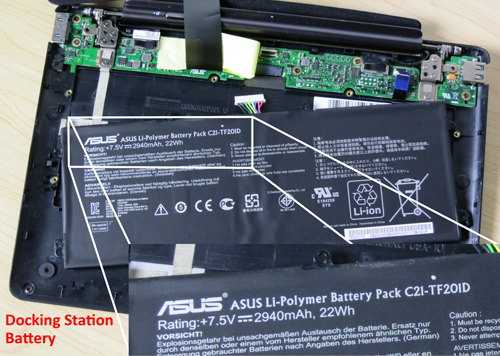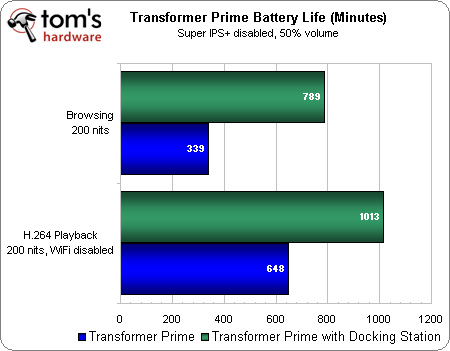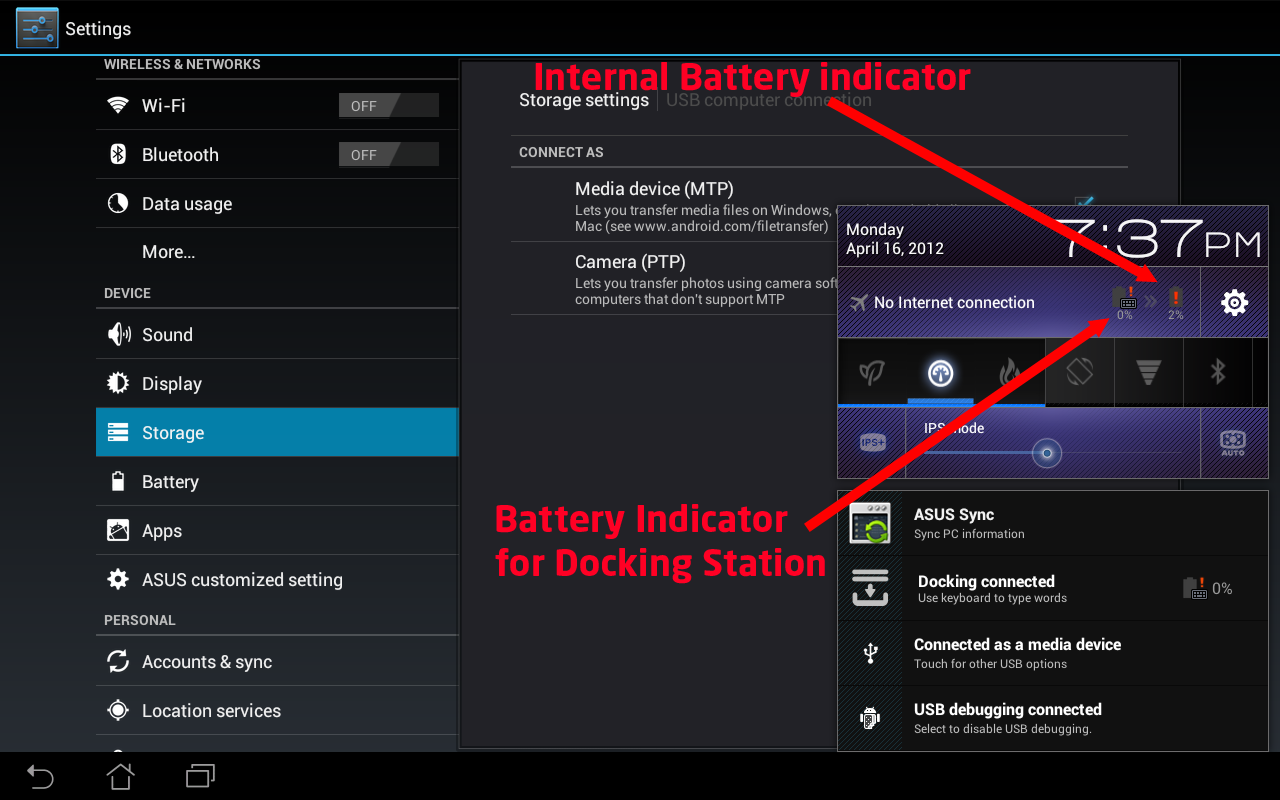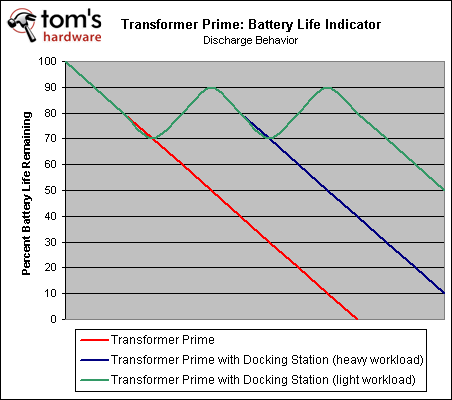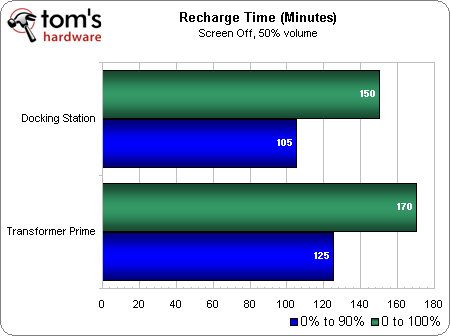Asus Transformer Prime TF201: A Tablet With A Higher Calling
Docking Station: The "Transformer" In Transformer Prime
Asus' docking station is one of the most important accessories to consider. After all, this is what makes the Transformer Prime, well, transform. And the option to use the tablet and dock together really sets Asus' offering apart from everything else. The docking station is sold separately for a hefty $149, which brings your total bill (assuming you buy the 32 GB model) up to $650. That's the same range as a number of very capable notebooks and high-end netbooks, necessitating a careful decision. Does a more portable experience justify what you'll spend?
In the video above, we used the Transformer Prime in much the same way we'd use a productivity-oriented laptop or netbook. The consensus is that paying extra for the dock is worthwhile if you want to use Asus' tablet as an alternative to one of those more traditional form factors. In utilizing Tegra 3, the Transformer Prime doesn't suffer some of the delays in response we encountered when we reviewed the original Transformer.
For example, when we'd enter a search phrase on the first Transformer's Web browser, the input stuttered during fast typing. And when we made a mistake, holding down the backspace key resulted in slow and delayed character deletion. That's no longer the case. Nvidia's quad-core Tegra 3 can handle the input more elegantly.
The docking station's USB port is truly functional. Rather than simply supporting removable media (something we've seen on other tablets), you can plug in an Xbox 360 wireless controller receiver, for instance. You don't need any additional drivers; it just works. PlayStation 3 owners can instead use Bluetooth connectivity, even without the docking station attached.
As if we haven't already driven home the idea of using Asus' Transformer Prime as a portable console, adding in controller support gets us even closer with a familiar interface.
Beyond its role in expanding I/O, the docking station also expands the Transformer Prime's battery capacity. The tablet's battery is marginally larger, holding 3380 mAh compared to the dock's 2940 mAh. Under certain workloads, the combined battery power should yield close to two times as much battery life compared to the tablet on its own.
There is variability in how long it takes to deplete the batteries, though, due to a rather uncommon charge/drain cycle built into the Transformer Prime's firmware. Instead of draining one battery and then the other, the transformed tablet first lets the main battery drop to 70%. Then, it recharges back up to 90% using the secondary power source before letting it drain again. This cycle continues until the docking station's battery can't provide any more juice. Presumably, both the tablet and docking station require power, necessitating this seemingly unconventional way of draining both batteries in a balanced manner.
Get Tom's Hardware's best news and in-depth reviews, straight to your inbox.
Charging operates under the sample principle, which makes our battery life benchmark a bit more complicated. The results presented on the previous page are straightforward measurements we took of the docking station and Transformer Prime while they charged individually. When both components are connected, charging together as one unit, a complete recharge takes a bit longer due to jugging between tablet and dock.
Current page: Docking Station: The "Transformer" In Transformer Prime
Prev Page Battery Life And Recharge Time Next Page HDMI Output And Camera Quality-
killerclick Is this a joke? Wait for the new iPad to come out and then review the Transformer Prime? Why didn't you review it sooner? Did Asus miss a payment or did Apple give you a little extra to keep a lid on it?Reply -
lancelot123 Wake me when it is running Windows on a x86 CPU so I can install whatever I want for free.Reply -
cangelini Reply9530586 said:Is this a joke? Wait for the new iPad to come out and then review the Transformer Prime? Why didn't you review it sooner? Did Asus miss a payment or did Apple give you a little extra to keep a lid on it?
Because we didn't have it sooner. -
joytech22 I was thinking of getting this until I caught wind of the Transformer T701.Reply
I think the 1080p display is worth the wait. -
DjEaZy ... that thing with the splash effect... i do believe, that it iz a program issue... 3rd gen iPad haz power to burn... you can program some splashes... it's like M$ say, that, to play crysis and see the rays thru treas, you needed vista and DX 10... it turned out, that it waz a tweak, that enabled it on XP too... and i believe, if apple will implement some open standard of some physics engine, like Bullet Open Source Physics, all of the open standard devices will benefit, android and iOS alike... and nVidia physx will be not relevant... to program some separate android+nVidia version of a game? ...when there is many different android devices, that don't use Tegra? ... it could end for nVidia, like it ended for 3DFX with there glide engine... 3Dfx waz killed by OpenGL and DirectX... 3Dfx's Glide waz visually superior, but OpenGL and DirectX helped then ATi and nVidia to go multiplatform and to the masses...Reply
... so, my point waz... prime is a nice thingy, but, if there are proprietary stuff on a open platform, like android... i don't believe, that Tegra can get some momentum without going open source... the question is... how big is the Tegra's market share on the android platform? ... and... is the market share for Tegra so big, that they can insist to use there proprietary things?... -
"While the Transformer Prime supports output over microHDMI, it cannot push 1080p through the wire" ...When using hardware decoding, Transformer Prime actually pushes true 1080p-video to the television (..while the tablets screen remains unused = black). As an owner of TF201, I can confirm this.Reply
-
mily U're bienvenida: D Gracias por venir a mi artículo .. Espero que lea mis otros artículosReply
.. Me interesa conocer sus puntos de vista .. gracias :)
Echo de menos los comentarios de Lippo durante el proceso de ruptura de la pared, no puedo
creer que redujo el papel de Lippo como el
camisetas hombre -
joytech22 DjEaZymy point waz... prime is a nice thingy, but, if there are proprietary stuff on a open platform, like android... i don't believe, that Tegra can get some momentum without going open source... the question is... how big is the Tegra's market share on the android platform? ... and... is the market share for Tegra so big, that they can insist to use there proprietary things?...Reply
Ehh...? I have no idea what you are trying to get at.
Is it your first time on the internet? :\
-
DjEaZy DjEaZy... that thing with the splash effect... i do believe, that it iz a program issue... 3rd gen iPad haz power to burn... you can program some splashes... it's like M$ say, that, to play crysis and see the rays thru treas, you needed vista and DX 10... it turned out, that it waz a tweak, that enabled it on XP too... and i believe, if apple will implement some open standard of some physics engine, like Bullet Open Source Physics, all of the open standard devices will benefit, android and iOS alike... and nVidia physx will be not relevant... to program some separate android+nVidia version of a game? ...when there is many different android devices, that don't use Tegra? ... it could end for nVidia, like it ended for 3DFX with there glide engine... 3Dfx waz killed by OpenGL and DirectX... 3Dfx's Glide waz visually superior, but OpenGL and DirectX helped then ATi and nVidia to go multiplatform and to the masses... ... so, my point waz... prime is a nice thingy, but, if there are proprietary stuff on a open platform, like android... i don't believe, that Tegra can get some momentum without going open source... the question is... how big is the Tegra's market share on the android platform? ... and... is the market share for Tegra so big, that they can insist to use there proprietary things?...joytech22Ehh...? I have no idea what you are trying to get at.Is it your first time on the internet? :\... smoke some and you will get the full picture...Reply -
In Italy Asus decided not to give the free dongle, because they say that it was selled as a localization system, and not a GPS, therefor, they will not help us improve our tablet experience. Since the prime doesn't have a 3G connectivity, I don't think the GPS is that important, also, a 10" GPS is quite annoying. I prefer to use the phone. Great review by the way. Although I don't trust benchmarka, nor asus ICS updates. At the biginning the wi-fi was working great, no overconsumption of power, now my battery drains in hours.Reply
